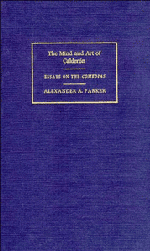Book contents
- Frontmatter
- Contents
- Author's preface
- Editor's preface
- Introduction
- I Stylistic and dramatic craftsmanship
- II From experience to myth
- III The tensions of social life
- 11 The functions of comedy
- 12 The vicissitudes of secrecy (1): La dama duende, El galán fantasma
- 13 The vicissitudes of secrecy (2): El astrólogo fingido
- 14 Secret betrothals and secret marriages: El postrer duelo de España
- 15 From comedy to tragedy: No hay cosa como callar
- 16 A Calderonian conception of tragedy: El pintor de su deshonra
- 17 The tragedy of honour: El médico de su honra
- IV The tensions of public life
- V From symbol to myth
- Epilogue
- Notes
- Index
12 - The vicissitudes of secrecy (1): La dama duende, El galán fantasma
Published online by Cambridge University Press: 05 February 2012
- Frontmatter
- Contents
- Author's preface
- Editor's preface
- Introduction
- I Stylistic and dramatic craftsmanship
- II From experience to myth
- III The tensions of social life
- 11 The functions of comedy
- 12 The vicissitudes of secrecy (1): La dama duende, El galán fantasma
- 13 The vicissitudes of secrecy (2): El astrólogo fingido
- 14 Secret betrothals and secret marriages: El postrer duelo de España
- 15 From comedy to tragedy: No hay cosa como callar
- 16 A Calderonian conception of tragedy: El pintor de su deshonra
- 17 The tragedy of honour: El médico de su honra
- IV The tensions of public life
- V From symbol to myth
- Epilogue
- Notes
- Index
Summary
Two of Calderón's best-known comedies come early in his career. They are Casa con dos puertas mala es de guardar (A House with Two Doors is Hard to Guard) and La dama duende (The Ghostly Lady), both of 1629. In chapter 2, it was stated that there are three principal types of dramatic symbols used by Calderón. The first is a place or object central to the development of the action and which therefore has a special significance. It was suggested that the two doors in each of the two houses in Casa con dos puertas … were symbols representing, in the first place, the two poles of convention round which social decorum had to oscillate, secrecy and the dissimulation that has to cover it up: one has to emerge from a door through which one has not entered; and, in the second place, the twoedged character of courtship and love, balanced precariously on a knife-edge – what is sought secretly and kept in secrecy can easily founder in jealousy. Just as the stage action is constructed on this dualism, so is the theme constructed on a constant duality, swaying between secrecy and deception, truth and falsehood, loyalty and betrayal, wooing and duelling, comedy and tragedy. The duality of the doors evokes duplicity in the explanations of the characters' conduct; among the characters themselves, these produce equivocal situations.
- Type
- Chapter
- Information
- The Mind and Art of CalderónEssays on the Comedias, pp. 143 - 152Publisher: Cambridge University PressPrint publication year: 1989

